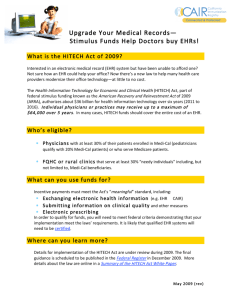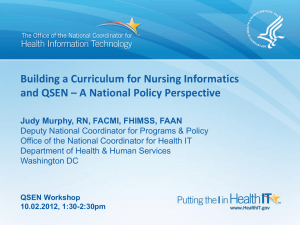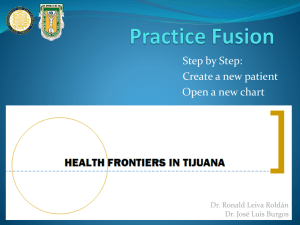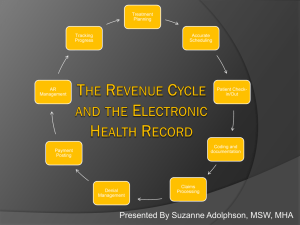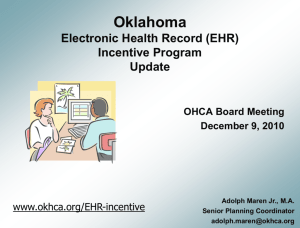Judy Murphy - American Academy of Nursing
advertisement
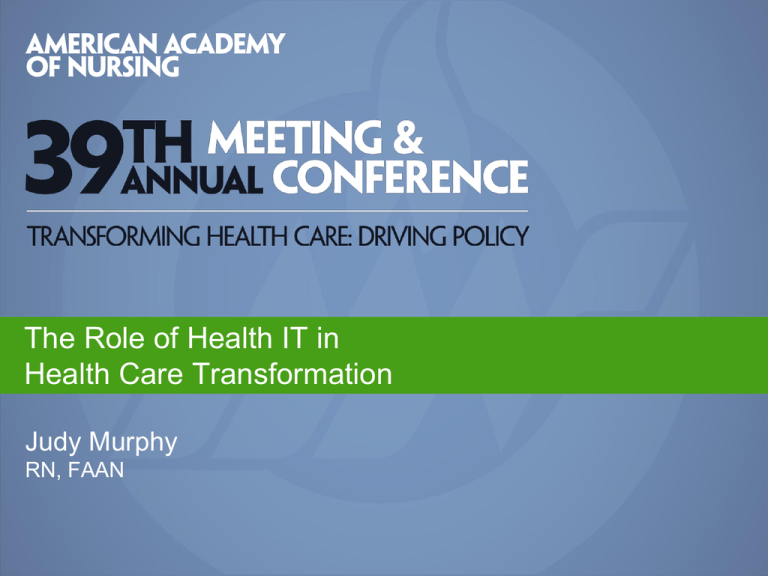
The Role of Health IT in Health Care Transformation Judy Murphy RN, FAAN The Role of Health IT in Health Care Transformation Judy Murphy, RN, FACMI, FHIMSS, FAAN Deputy National Coordinator for Programs & Policy Office of the National Coordinator for Health IT Department of Health & Human Services Washington DC Transforming Health Care: Driving Policy 10-12-2012, 9 - 10am 2 What I Will Cover . . . • Today’s Health IT landscape • Quality and the new IOM Report • Consumer eHealth 3 A Bit of History … • President Bush’s goal in 2004 “… an Electronic Health Record for every American by the year 2014. By computerizing health records, we can avoid dangerous medical mistakes, reduce costs, and improve care.” - State of the Union address, Jan. 20, 2004 • Executive order established the Office of the National Coordinator for Health Information Technology (ONCHIT) as part of the Dept of Health & Human Services (HHS) – Dr. David Brailer appointed the first National Coordinator 4 The Time is Now … • President Obama’s goal in 2009 “To lower health care cost, cut medical errors, and improve care, we’ll computerize the nation’s health records in five years, saving billions of dollars in health care costs and countless lives.” - First Weekly Address Jan. 24, 2009 • February 17, 2009 – the American Reinvestment and Recovery Act (ARRA – Stimulus Bill) is signed into law – HITECH component of ARRA provides an incentive program to stimulate the adoption and use of HIT, especially EHR’s – Dr. David Bluementhal appointed the new National Coordinator 5 American Recovery & Reinvestment Act of 2009 (ARRA / Stimulus Bill) • • • • HR 1 -- 111th Congress $787 Billion Highly partisan vote Healthcare gets $147.7 Billion • • • • $87B for Medicaid $25B for support for extending COBRA $10B for NIH HITECH Component: • $22.5B for EHR Incentives through CMS • $2B for HIT Support Programs through ONC HITECH = Health Information Technology for Economic and Clinical Health 6 The focus on HIT continues … PPACA Mar 2010 (Patient Protection & Affordable Care Act) IOM Future of Nursing Report Oct 2010 PCAST Report Dec 2010 (President’s Council of Advisors on Science & Technology) “There is no aspect of our profession that will be untouched by the informatics revolution in progress.” - Angela McBride, Distinguished Professor and University Dean Emeritus Indiana University School of Nursing 7 A Remarkable Journey 8 Progress of Eligible Professionals Toward EHR Incentive Payments Source: CMS EHR Incentive Program Data as of 8/31/2012 9 Progress of Eligible Hospitals Toward EHR Incentive Payments Note: Totals reflect the number of unique hospitals that have received payments from Medicare or Medicaid. Source: CMS EHR Incentive Program Data as of 8/31/2012 10 Meaningful Use – All Payments as of August 31, 2012 ($ in Millions) Payments to All Eligible Professionals and Hospitals Under the Medicare or Medicaid EHR Incentive Programs $900 $8,000 $836 Cumulative Total $7,120 $800 Source: CMS EHR Incentive Program Data $659 $619 $608 $600 $563 $6,000 $620 $586 $5,000 $505 $500 $428 $387 $400 $4,000 $396 $3,000 $276 $300 $237 $2,000 $200 $116 $109 $80 $100 $22 $0 Cumulative Amount Paid (Millions) Amount Paid per Month (Millions) $700 $7,000 $16 $26 $1,000 $31 $0 11 EHR Adoption by Ambulatory Providers as of 8-31-12 12 HIT as the means, not the end Dr. David Blumenthal, previous National Coordinator of HIT, emphasizes “HIT is the means, but not the end. Getting an EHR up and running in health care is not the main objective behind the incentives provided by the federal government under ARRA. Improving health is. Promoting health care reform is.” - At the National HIPAA Summit in Washington, D.C. on September 16, 2009 13 Our National Quality Strategy Better Health for the Population Better Care for Individuals Lower Cost Through Improvement 14 Health IT: Helping to Drive the 3-Part Aim Better healthcare Improving patients’ experience of care within the Institute of Medicine’s 6 domains of quality: Safety, Effectiveness, PatientCenteredness, Timeliness, Efficiency, and Equity. Better health Keeping patients well so they can do what they want to do. Increasing the overall health of populations: address behavioral risk factors; focus on preventive care. Reduced costs Lowering the total cost of care while improving quality, resulting in reduced monthly expenditures for Medicare, Medicaid, and CHIP beneficiaries. $ Health Information Technology 15 Meaningful Use as a Building Block Transform health care Improved population health Access to information Enhanced access and continuity Data utilized to improve delivery and outcomes Data utilized to improve delivery and outcomes Patient self management Patient engaged, community resources Care coordination Care coordination Patient centered care coordination Patient informed Evidenced based medicine Team based care, case management Basic EHR functionality, structured data Structured data utilized Registries for disease management Registries to manage patient populations Privacy & security protections Privacy & security protections Privacy & security protections Privacy & security protections Stage 2 MU PCMH 3-Part Aim ACO’s “Stage 3 MU” Utilize technology Stage 1 MU 16 Quality Measurement Enabled by Health IT • Released July 2012 • Contains a catalog of over 70 activities related to health IT and quality measurement • Describes possibilities for the next generation of quality measurement • Illustrates challenges facing advancement http://healthit.ahrq.gov/HealthITEnabledQualityMeasurement/Snapshot.pdf 17 Best Care at Lower Cost The Path to Continuously Learning Health Care in America September 2012 iom.edu/bestcare Why now? Quality – persistent shortfalls • Patient harm – One-fifth to one-third of hospital patients are harmed during their stay, largely preventable. • Recommended care – Only about half of the recommended preventive, acute, and chronic care is actually received. • Outcome shortfalls – If all states matched care quality in the highest-performing states, 75,000 fewer deaths would have occurred in 2005. Why now? Costs – unsustainable levels, waste • Absolute expenditures – $2.6 trillion (2009), 17% GDP • Relative expenditures – 76% increase health costs in past 10 years, overwhelming the 30% gain in personal income • Wasted expenditures – $750 billion (2009) • Opportunity costs – e.g. total waste could pay salaries of all first response personnel for 12 years Why now? Complexity – exponentially increasing • Increasing information – Over 800,000 new journal articles per year; up 4-fold from 1970. • New diagnostic factors in play – phenotypes, genetics, and proteomics. • Multiple treatment factors in play – e.g. 19 medications per day for 79 year-old patient with osteoporosis, type 2 diabetes, hypertension, and chronic obstructive lung disease; over 200 other doctors are also providing treatment to the Medicare patients of an average primary care doctor. The Result? The U.S. health care system today The Vision Continuous Learning, Best Care, Lower Cost 10 Recommendations Foundational elements 1. The digital infrastructure – Improve the capacity to capture clinical, delivery process, and financial data for better care, system improvement, and creating new knowledge. 2. The data utility – Streamline and revise research regulations to improve care, promote the capture of clinical data, and generate knowledge. Care improvement targets 3. 4. 5. 6. 7. Clinical decision support Patient-centered care Community links Care continuity Optimized operations Supportive policy environment 8. Financial incentives. 9. Performance transparency 10. Broad leadership HealthIT.gov website for patients 25 Back in the Day… “The obedience of a patient to the prescriptions of his physician should be prompt and implicit. [The patient] should never permit his own crude opinions as to their fitness to influence his attention to them.” - AMA’s Code of Medical Ethics (1847) 26 And Now… “Patients share the responsibility for their own health care….” - AMA’s Code of Medical Ethics (current) “Patients can help. We can be a second set of eyes on our medical records. I corrected the mistakes in my health record, but many patients don't understand how important it will be to have correct medical information, until the crisis hits. Better to clean it up now, not when there’s time pressure.” – Dave deBronkart (ePatient Dave) 27 Consumer eHealth Pledge Program www.healthit.gov/pledge Over 400 organizations have Pledged to provide access to personal health information for 1/3 of Americans… 28 Consumer Involvement is critical LINK: http://youtu.be/QCc6QgYUFEM 29 Million Hearts – Provider Goals 30 Million Hearts - Consumer Challenge 31 Consumer Video Challenge Winner Dr Funky's Blood Pressure Management Rx http://bloodpressure.challenge.gov/submissions/7498-dr-funky-s-bloodpressure-management-rx 32 Stage 2 Meaningful Use Criteria FOCUS ON INTEROPERABILITY • E-prescribing • Transition of Care summary exchange: • Create & transmit from EHR • Receive & incorporate into EHR • Lab tests & results from inpatient to outpatient • Public health reporting – transmission to: • Immunization Registries • Public Health Agencies for syndromic surveillance • Public health Agencies for reportable lab results • Cancer Registries • Patient View, Download and Transmit to 3rd Party 33 What’s in Your Health Record - Consumer Challenge 34 Consumer Video Challenge Winner Mark’s Story http://yourrecord.challenge.gov/submissions/9688-mark-s-story 35 OpenNotes: What Was Learned Tom Delbanco, MD; Jan Walker, RN, MBA; et al Supported by: The Robert Wood Johnson Foundation With additional funding from the Drane Family Fund and the Richard and Florence Koplow Charitable Fund OpenNotes study results (Annals of Internal Medicine: 2 October 2012, Vol 157, No 7) Includes editorials by Michael Meltsner, an OpenNotes patient and Carol Goldzweig, from the Veterans Health Administration http://annals.org/article.aspx?articleid=1363511 www.myopennotes.org About the OpenNotes Study http://www.youtube.com/watch?v=x-0KdtcBwfI • More than 19,000 patients • 105 volunteer primary care physicians • 3 diverse sites – Beth Israel Deaconess Medical Center – Geisinger Health System – Harborview Medical Center • 12 months of sharing notes www.myopennotes.org Patients Were Enthusiastic • Patients used the notes • Up to 92% of patients across the 3 sites read their doctor’s note(s) • Patients reported important benefits • Feeling more in control of their care (77-87%) • Better understanding of health and medical conditions (77-85%) • Doing better with taking their medications (60-78%) • Patients were rarely (1-8%) confused, worried, or offended by what they read in their doctors’ notes www.myopennotes.org Doctors Experienced Little Disruption and Observed Benefits • Few doctors reported impacts on their workflow • Longer visits (0-5%) • More time addressing patients’ questions outside of visits (0-8%) • Some doctors changed how they wrote notes • 0-21% reported taking more time writing notes • 3-36% reported changing the way they wrote about mental health, substance abuse, cancer, and obesity • Many doctors described strengthened relationships with their patients www.myopennotes.org Thank you! For more information, contact: judy.murphy@hhs.gov 40

